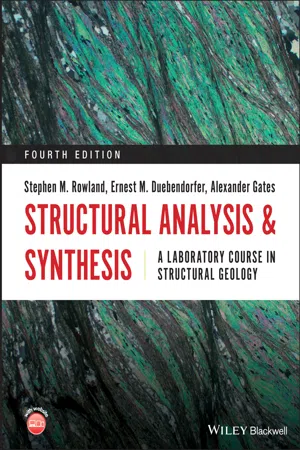
Structural Analysis and Synthesis
A Laboratory Course in Structural Geology
- English
- ePUB (mobile friendly)
- Available on iOS & Android
Structural Analysis and Synthesis
A Laboratory Course in Structural Geology
About this book
STRUCTURAL ANALYSIS & SYNTHESIS A LABORATORY COURSE IN STRUCTURAL GEOLOGY
Structural Analysis and Synthesis is the best-selling laboratory manual of its kind. Specifically designed to support the laboratory work of undergraduates in structural geology courses, the book helps students analyze the various aspects of geological structures, and to combine their analyses into an overarching synthesis.
This book is intended for use in the laboratory portion of a first course in structural geology. As is explicit in the book's title, it is concerned with both the analysis and synthesis of structural features. In this fourth edition, the has been broadened to include a range of new content and features, including:
Structural Analysis and Synthesis is a renowned and widely recognized aid to students in grasping and mastering the techniques required in structural geology, and will find a home wherever the principles and practices of structural geology are taught.
Frequently asked questions
- Essential is ideal for learners and professionals who enjoy exploring a wide range of subjects. Access the Essential Library with 800,000+ trusted titles and best-sellers across business, personal growth, and the humanities. Includes unlimited reading time and Standard Read Aloud voice.
- Complete: Perfect for advanced learners and researchers needing full, unrestricted access. Unlock 1.4M+ books across hundreds of subjects, including academic and specialized titles. The Complete Plan also includes advanced features like Premium Read Aloud and Research Assistant.
Please note we cannot support devices running on iOS 13 and Android 7 or earlier. Learn more about using the app.
Information
1
Attitudes of Lines and Planes
Objectives
- Measure planes and lines in the field using standard techniques.
- Become familiar with the azimuth and quadrant methods for defining the orientations of planes, lines, and lines within planes.
- Draw and read back orientations on maps.



Table of contents
- Cover
- Table of Contents
- Title Page
- Copyright Page
- Preface
- About the Companion Website
- 1 Attitudes of Lines and Planes
- 2 Outcrop Patterns and Structure Contours
- 3 Stereographic Projection
- 4 Folds and Cross Sections
- 5 Stereographic Analysis of Folded Rocks
- 6 Rotations and Determining Original Directions in Folded Rocks
- 7 Foliations, Parasitic Folds,and Superposed Folds
- 8 Strain Measurements in Ductile Rocks
- 9 Advanced Strain Measurements
- 10 Brittle Failure
- 11 Analysis of Fracture Systems
- 12 Faults
- 13 Dynamic and Kinematic Analysis of Faults
- 14 Structural Synthesis
- 15 Deformation Mechanisms in Mylonites
- 16 Construction of Balanced Cross Sections
- 17 Introduction to Plate Tectonics
- 18 Virtual Field Trip
- References
- Further Reading
- Index
- End User License Agreement